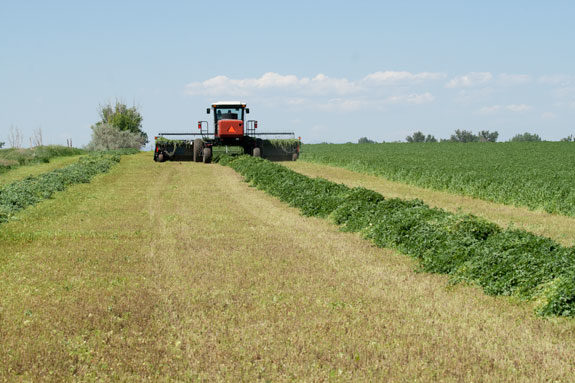The days are racking up heat units just as sure as if it were May. The hay crop in most areas is progressing so early that you could have the opportunity for an extra cutting of hay or haylage during 2012.
And while it’s not too early to get that trusty harvesting equipment greased and ready to go, take a moment to ponder the trade-off between yield and quality, and listen to what your hay market (or your cows) might be telling you.Forage quality is always a consideration when buying or selling hay, and when deciding how much hay or haylage to include in a ration versus other crops or commodities you could feed.
Unprecedented values for hay and haylage are making some people reconsider the way they think about the trade-off between forage yield and forage quality.
Hay markets of late have been ‘telling’ some commercial hay growers to produce more tons (yield) even when those tons have a bit lower forage quality.
Will that trend continue beyond the first cutting of 2012 when hay and haylage inventories begin to build again? Will the emphasis shift back to forage quality? Will stockers who needed hay last season find relief in spring and summer weather that allows their pastures to recover?
And what of large dairies that bought and fed less hay due to high prices? Will they purchase more if and when the price returns to levels that merit including more high quality hay in their dairy rations?
If you’re a commercial hay grower, you’ll want to know what your hay customers are thinking about these questions. And if you’re feeding hay or haylage, you’ll want to consider your forage inventories and 2012 to 2013 intentions for hay and haylage inclusion rates, and forage quality you need in your rations.
Deciding when to take your first cut is an important decision. The timing of first cutting can affect the total amount of forage you produce for the season, and the forage quality of the first cut. I see three potential cutting strategies to choose from given the early season:
1. Manage your cuttings for high quality – Take the first and subsequent cuttings at bud stage for dairy-quality hay or haylage in every cut.
With any luck for continued mild spring weather you’ll have a shot at an extra ‘bonus’ cutting by the end of the 2012 growing season. That can mean more yield overall without sacrificing quality, but also the expense of an extra harvest.
2. Manage your first cutting for high yield, then take subsequent cuttings at your usual growth stage for renewed emphasis on forage quality.
This might reduce your chance for that ‘bonus’ cutting by the end of 2012. But it may help you strike a balance between your overall need for hay or haylage inventory, with some higher forage quality in the mix.
3. Manage for high yield with less emphasis on forage quality – delay the first cut and plan on extending the cut interval for subsequent cuttings too.
This strategy would seek to increase yield per cutting with the potential for longer cut intervals given the early spring start for 2012. Since a reduction in forage quality is also likely, you’ll want to consider that in relation to the increased yield potential of extended cutting intervals.
First cut yield of alfalfa increases through full flower. You can maximize yield in subsequent cuttings with cut intervals of 40 to 45 days. What’s the trade-off between yield and quality? In alfalfa, each day of harvest delay can equate to:
• The level of crude protein in the plants drops by 0.5 percent.
• The level of acid detergent fiber (ADF) increases by 0.7 percent.
• The amount of neutral detergent fiber (NDF) in the alfalfa increases by 0.9 percent.
A common goal for dairy quality hay is 20 percent crude protein, 30 percent ADF and 40 percent NDF. It only takes five to six days for the quality to decline to 17 percent, 34 percent and 45 percent, respectively. When the ration doesn’t account for these higher fiber levels, feed intake can drop and so can milk production.
For cool season grasses, you can maximize yield by taking the first cutting soon after seed heads emerge from the ‘boot.’ Waiting longer doesn’t add much to yield, but quality declines as the seed heads mature. Forage quality of later cuttings is less prone to decline, since later cuttings will not develop elongated stems and seed heads.
Harvest timing is critical to striking the balance you want between yield and forage quality. When crop maturity and weather conditions are right, good harvest management – including attention to cutting management and use of an inoculant in haylage – can help producers preserve nutrients and economic returns. FG
FG staff photo.

Robin Newell
Forage Business Manager
Pioneer Hi-Bred











